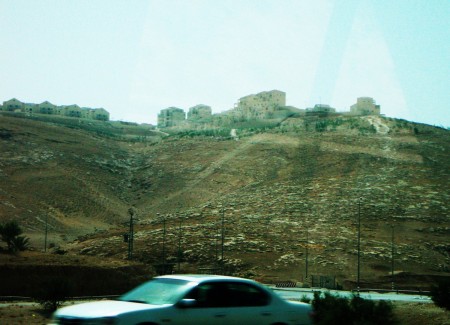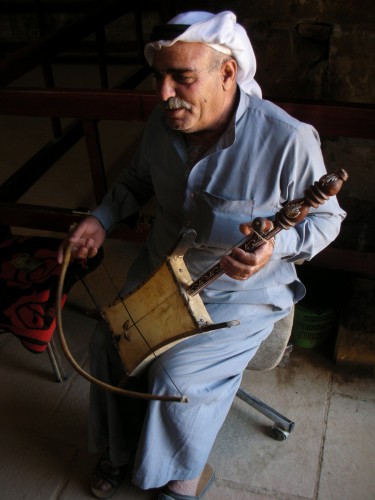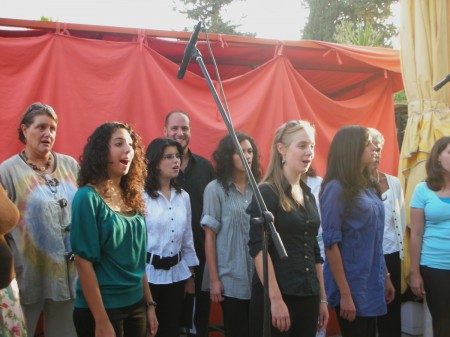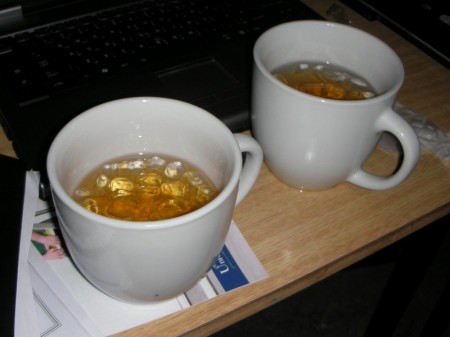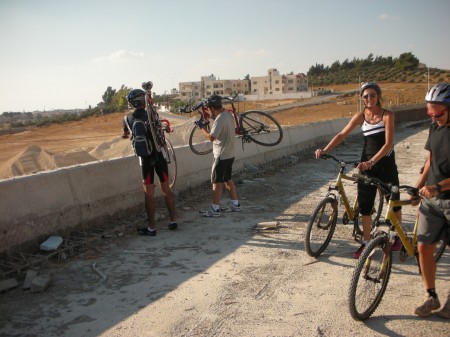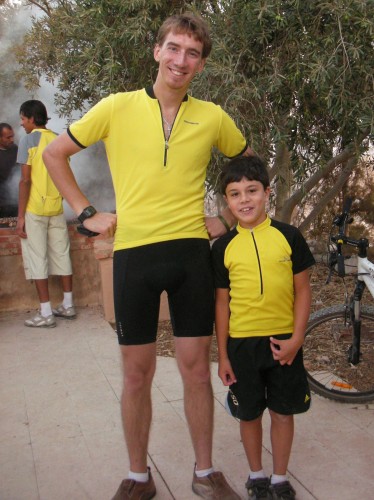or the next two days after we returned from the southern desert, I caught up on my work and my parents traveled with another JD Tours driver to the northern sites of Jordan, such as Um Qais, Ajloun, and Jerash. I wanted to go with them, but there’s no way I could have been at ease leaving my job(s) unattended for two and a half straight weeks; I needed those two days to make sure that everything was working properly, and to teach. I’m sure my students would have missed me, anyway. Besides that, I took my parents to dinner at Haitham’s house in Zarqa’ where they got to experience real homemade mensaf, made with love, care, and extra sauce. Haitham proudly presented us with large plates mounded high with lamb and rice and potato, which we all quickly demolished before chatting with Haitham and his parents about life, work, and teasing me in what I hope was an affectionate way.
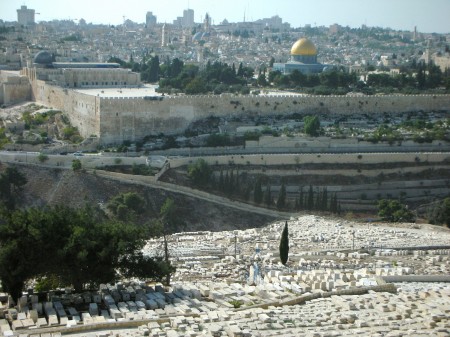
The famous view overlooking the Old City from Mount Olives. Foreground is the Jewish cemetery, with the Al-Aqsa mosque and Dome of the Rock behind.
One of the highlights of my parents’ trip to the Middle East was to be the Dozan wa Awtar choir trip to the Holy Land, Palestine, to see Jerusalem, Nazareth, the Sea of Galilee, and Bethlehem – all important and famous historical Christian sites. The culmination of it would be singing in the Church of the Holy Sepulchre which encloses what remains of the Hill of Golgotha and Jesus’ burial site. The whole tour would be paid for and tour buses would ferry us around the various other sites. Board would be free for choir members, and families (such as mine own and several other interested parties) would be get excellent discounted rates on 5-star hotel rooms. We would sing “Al-Zahara al-Madaa’en” (The Flower of the Cities), which was written about Jerusalem, in Jerusalem. It would be amazing.
Then the whole thing was canceled, the day beforehand. “What could happen, after all that planning, practicing, and scheduling!” you may ask. Israel happened, of course! Our favorite people across the river decided to throw an extra dozen papers and forms at the Jordanian and Diplomatic Visa-holders in the choir group, and there was no way to get it all done in time before we were scheduled to leave. So the whole thing had to be scrapped thanks to the wonderful, lovely Israeli government. Thanks, chaps – right kind of you. PS: I hope you enjoy never being able to leave your own country because your passports have the same appeal as the Black Plague to the rest of the world.
Slight bitterness aside, we decided that just because Israel security was less than intelligent, we weren’t going to be stopped from having a fun vacation in Palestine. The Tulip family (frequent commenters on this blog) felt the same way, and together the two families took one extra day of rest to replan an entire trip and left early on Friday morning, the second of October. Considering that she was only given one day of warning, my mother pulled things together in her typical excellent way. With almost inconceivable foresight to this cancellation, she had even brought a “Guide to Israel” guidebook with her and we spent Thursday (the day we were supposed to have left) figuring out where we would stay and what we would do.
The ride to the border was simple and wonderfully inexpensive (cue ominous foreshadowing) at only 12 JD for the ride to the border, and then another 3JD for the specially-licensed servecee taxi to take us the last bit of the way. Because of (guess) more border security (you guessed it), any taxi or public transport you take has to stop about a kilometer away from the border and then you need to switch into what is essentially an identically beat-up, banged up bus or taxi, and pay more money to go the last 3 minutes. Oh well, like I said – at least it was cheap.
The bouncy transport systems weren’t finished. It took another trip for the three of us by a large tourist bus (JD15 I believe, including our baggage fees) to actually cross over the Jordan Puddle (no way I’m calling that dribble a river), now joined by the Tulips. On the other side of the river, things changed very noticably and very quickly.
Our bus swung to a wheezing halt in front of a low, squat building…the Israeli border security and clearance center. Notices written in Arabic, Hebrew, and English were posted everywhere, something along the lines of “Abandon hope all ye who enter here.” Standing there to “greet” us as we exited the bus was a tall Israeli boy who rather resembled a curly-headed brick wall. Holding a loaded M-16 machine gun. And wearing khaki shorts, polo short, shades, and a (poorly) hidden mic under his shirt on the left shoulder, which he gripped self-importantly every few moments and muttered Hebrew into it. I say “boy” because he was just the first of many Israeli “soldiers” all over the base which looked as if they were either ready for spring break in Cancun (like this guy) or were wearing their dad’s baggy soldier uniform. Speaking of which, this gentleman was maybe one of five males I saw during the entire 1.5 hour stay in the base. The vast majority of soldiers were young women who looked as if they should be talking about their latest boyfriend and arguing about senior prom, instead of wearing pistols strapped to their belts and glaring suspiciously at my Tajiki and Uzbeki visas in my passport. The girl who questioned me stared at them in confusion, having probably never before seen those two large stickers that take up an entire passport page. “What were you doing there, and why? Who were you staying with and how did you know them? What was their family name?” was an example of some of the questions that were fired at me. My mother elbowed me and told me to mention that their daughter stayed with the family in America and the father works at the U.S. Embassy. Even so, the girl took my passport to an office a few meters away and vanished for several minutes. I can only imagine how that conversation went.
- Girl: Quick, boss – where’s Tajikistan? And do they hate us too?
- Bored office guy: Next to India or something. Naw, I guess they’re cool.
After being fingerprinted and photographed by another soldier, plus one final cattle-herd like line of people shuffling forward to get their Israeli-scanned luggage, which had already been scanned twice before, we were through. Abu Tulip arranged a microbus for all of us and using his fluent Arabic, negotiated what west of the river may call a “fair price” and what we east of the river would call “a little bit steep.” No problem, though – with three young children in the Tulip family, the main order of business was getting us to Jerusalem and to some lunch!
Dad said up near the front seat and chatted with the driver, who spoke a little English and was happy to talk. Like myself, dad had been forced to put the filming and photographing devices away for the last few hours as we were in “security” territory, but now that we were free of the border region and moving westward, he quickly dug out his camcorder and fired it up, just in time to catch The Separation Wall up on the hill above us.
It was the first time I’d ever seen it in anything but pictures and online videos, and even though we were quite far away from it, it still struck me with its sense of foreboding, segregation, and loss. In this particular area, the wall wasn’t so much a separate, free-standing entity but more of a component of the luxurious-looking Israeli apartments built above it. All the land we had been driving through since leaving the border was technically Palestinian (remember, this means nothing as Israel occupies it all anyway) and these high walls were built facing the desert to keep everyone else out, but at the same time provide apartment inhabitants with a beautiful view of the desert and the Jordan Valley behind us. I can’t look at these gashes of separation without wondering what might have been there over the past few hundred years. An olive farm? A village? Israelis touts themselves as being a beacon of modernity, an oasis in a land surrounded by desert and despotic rulers – I’ve actually seen comments with those phrases used in pro-Israel blogs and forums before. But these walls, separating the modern apartments, parks, libraries, and swimming pools from the desert sands, only serve to fill my stomach with a feeling of dread and nausea.
For that reason, I’m glad that we spent almost the entire duration of our time in Jerusalem in the beautiful Old City section, the historical treasure of Jewish, Muslim, and Christian history. We left our driver behind near the “New Gate” of the Old City (so named for being “only” one hundred years old, as opposed to thousands) and quickly found our hotel, the Knights’ Palace between the New Gate and the large and famous Jaffa Gate. We only took the time to drop off our well-scanned luggage in the hotel room, taking but a moment to admire the medieval suits of armor and paintings of Crusaders that hung in the wide stone hallways. Apparently the building had once been a theological seminary, but these days they merely harbor an odd love of Henry Kissinger in a knight costume (This amusing painting was hanging right next to our stairway).
